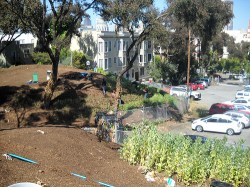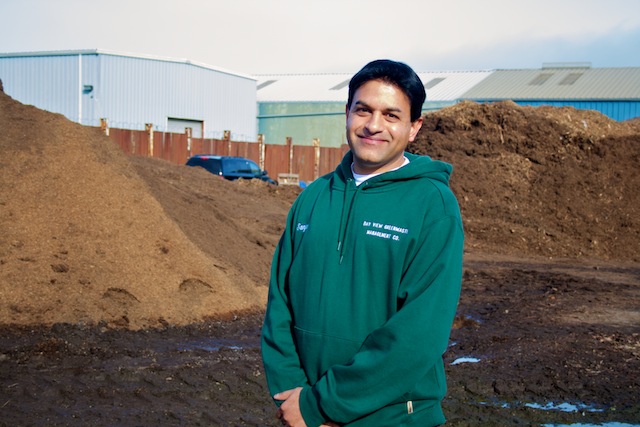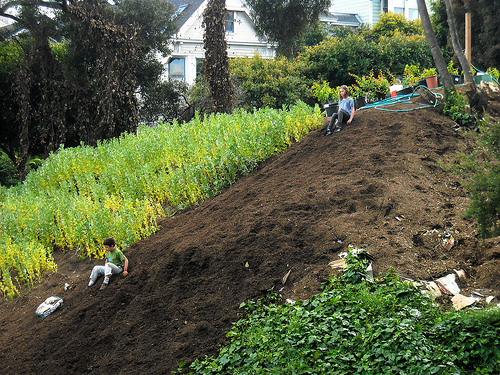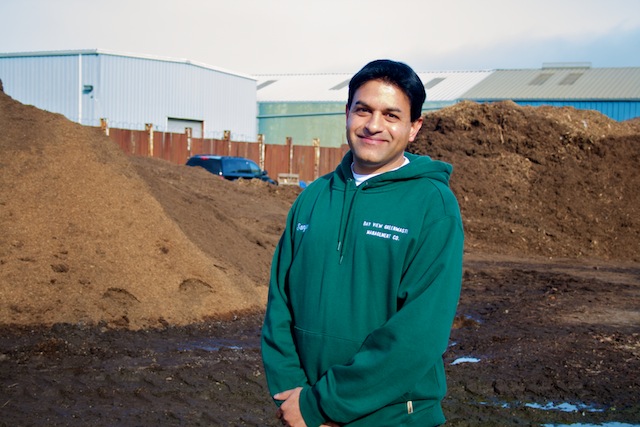
Hayes Valley Farm is flourishing where a freeway ramp used to be. (Photo by Zoey Kroll.)
Just a few years ago, they were abandoned freeways, dilapidated back yards, and institutional dumping grounds. But today, thanks to San Francisco’s urban agriculture renaissance, many of these pockets of underutilized land are being transformed. And one local company — Bayview Greenwaste — is playing a key role, by transforming waste into mulch, and giving it away.
The city’s largest agricultural experiment to date may be the Hayes Valley Farm, which is growing on the former site of a freeway ramp. The ramp was demolished, but the lot sat empty for years as development funding wilted in the recession. Then, in January of 2010, a dedicated group of farmers and permaculturalists began to convert the property into usable farmland.
With a border of mature trees and areas of direct sun, the location was well-suited for gardening. But the soil needed work. It was polluted, choked with weeds, and lacking in nutrients.
That’s where Bayview Greenwaste came in. Hayes Valley Farm spread tons of the company’s high-quality mulch across the lot over the past year — and they haven’t had to pay for a single pound.
Sanjay Bhas founded Bayview Greenwaste in 1998. The company, located on the city’s southern waterfront, collects plant waste — for a fee — and then grinds the organic matter into mulch that it gives away for free to anyone who wants it. Nonprofits, municipalities, private citizens, schools, and power plants (which burn organic matter instead of coal) count themselves among the company’s beneficiaries.
At Hayes Valley Farm, Bayview’s raw material was essential. Volunteers began by laying down a layer of cardboard, followed by ground-up organic matter, a process known as sheet-mulching. “As far as I know, it’s the largest sheet-mulching project ever done,” said David Cody, one of the Hayes Valley Farm’s founders. “It takes a forest hundreds of years to make an inch of topsoil. Hayes Valley Farm will make two feet of topsoil in less than five years.”
They’ve cultivated the mulch by planting fava beans and clover, which recharge nitrogen levels. Urban farmers have been re-learning the sustainable farming techniques last seen in the city a century ago. Now plants will thrive where cars once roared through, surrounded by existing old trees, beehives, red-tailed hawks, and an increasing population of butterflies.
“Before Sanjay was around, all that compost was going to the dump,” Cody said.
 Sanjay Bhas and his mulch at Bayview Greenwaste.Photo: Matt BaumeOn a recent day, Bhas stood on the grounds of Bayview Greenwaste next to a pile of branches, leaves, and tree stumps. He estimated that the pile of debris, the size of a small house, would take a few hours to grind.
Sanjay Bhas and his mulch at Bayview Greenwaste.Photo: Matt BaumeOn a recent day, Bhas stood on the grounds of Bayview Greenwaste next to a pile of branches, leaves, and tree stumps. He estimated that the pile of debris, the size of a small house, would take a few hours to grind.
Making healthy mulch is a science. Bhas uses a giant thermometer to measure the internal temperature of the piles to make sure they’re hot enough to kill organisms, and frequently tests for lead and arsenic.
“It’s a learning process every day,” he said.
Bayview Greenwaste occupies a key role in San Francisco’s burgeoning gardening scene. Community gardens have blossomed around the city in the last decade. According to the Recreation and Park Department’s last count, there are three dozen gardens on public land, and countless more on private lots.
Francesca Vietor, the newly appointed president of the San Francisco Public Utilities Commission, has directed her staff to identify more city land that can be used for urban farming and food production. The city is also exploring changes to outdated laws that prohibit residents from selling homegrown produce.
High on the slope of Potrero Hill hides a small community garden known simply by the nearby intersection: Eighteenth and Rhode Island. Like the Hayes Valley Farm, it was an empty lot until someone decided it could be put to better use. The property owner, a physician, granted gardeners permission to fortify the soil, to plant trees, and to construct a greenhouse.
“We’ve grown thousands of pounds of food in this tiny little space,” says David Cody — thanks, in part, to mulch provided by Bayview Greenwaste.
Bayview Greenwaste’s mulch can be found at local schools as well. A program called Urban Sprouts maintains gardens at six public schools, with 750 students per year learning to grow food, flowers, and herbs.
“We’re a really small grassroots organization,” said Audrey Roderick, Urban Sprouts’ program director. “So having access to large quantities of materials is important.” Staff use car-shared pickup trucks to haul mulch to their installations.
At Ida B. Wells High School, Urban Sprouts augmented its operation with beehives. Another garden abuts McLaren Park, drawing large flocks of birds. In the future, Roderick hopes to cultivate fruit trees.
The group’s biggest installation is at Log Cabin Ranch, a city-run “post-adjudication facility” for “delinquent” young men 45 miles south of the city, isolated from civilization and surrounded by wilderness.
The Ranch’s tennis court was too dilapidated to use, and the city didn’t have the funds to fix it, so Urban Sprouts turned to reliable old sheet-mulching tactics to transform the court into a garden. “It’s an urban ag demonstration in a very rural area,” said Roderick.
Another mulch recipient is the Free Farm, an agricultural installation on an empty city lot that housed a church before it burned down. A constellation of Episcopalian, Lutheran, and secular organizations teamed up with the property owner, St. Paulus Lutheran Church, to turn the quarter-acre sunken pit into a garden.
“The lot was all weeds, so we sheet-mulched,” said Joshua Griffin, an environmental justice missioner with the group. “Our entire surface, except for the beds, all of the paths and the labyrinth are all from Bayview Greenwaste,” said Griffin.
So far, they’ve produced 2,500 pounds of produce, according to Griffin — greens, potatoes, beans, squash, tomatoes, broccoli, and plenty of favas. They give the food away for free on weekends.
Private companies are also beneficiaries. “We’re an edible-landscaping company,” said Catherine Butler, owner of Urban Edibles, “with the idea of growing food where people live.”
Urban Edibles maintains about 10 gardens around town, mostly in low-density neighborhoods like the Sunset and Bernal Heights. Butler uses Bayview Greenwaste for sheet-mulching, and discovered that the mulch makes prime material for vermiculture – that’s worm-farming, for the uninitiated — when a neglected potato tower tipped over. “That’s how the worms got in there, and I found that they just loved it,” she said.
Bayview mulch has been a boon for private backyard gardens, too. San Francisco resident Ross Yeo used it to jump-start his own 1,000-square-foot plot, where he grows native plants, flowers, and a couple small fruit trees. “I think it’s great for projects where you need a large quantity of material to get started,” he said.
 Good clean fun at Hayes Valley Farm.Photo: Zoey KrollMost of these installations are in it for the long haul, but the Hayes Valley farm could go away if the lot’s owner finally secures financing for long-promised condos.
Good clean fun at Hayes Valley Farm.Photo: Zoey KrollMost of these installations are in it for the long haul, but the Hayes Valley farm could go away if the lot’s owner finally secures financing for long-promised condos.
But David Cody is optimistic. “Maybe the economy will get to the point when we don’t need condos,” he said, though it’s hard to imagine a day when the San Francisco real estate game ceases to be lucrative.
Even if the farm eventually vanishes, its painstakingly nitrogen-charged soil displaced by a new building’s foundation, it will still have spurred a transformation around the city.
“That’s one of our legacy goals,” Cody said. “It’s a depot where people are coming to learn, and then exporting knowledge, plants, and soil to take back to their backyard.” All you need to get started is a nice load of mulch.



